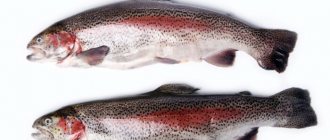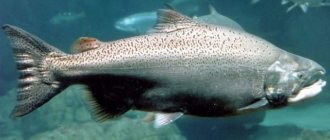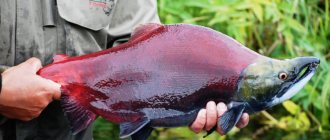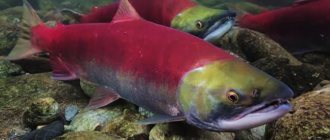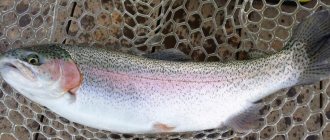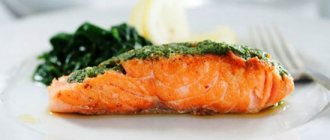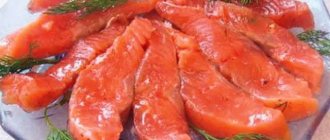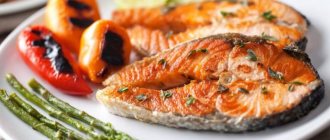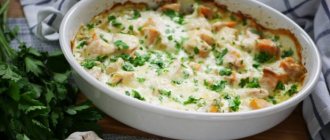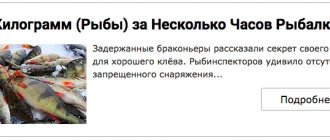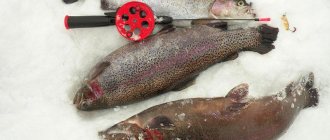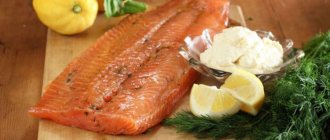Trout
Now let's talk about trout. This fish is found in lakes and also has a number of beneficial properties, like salmon. So, what qualities is this fish famous for? It contains elements such as zinc, iodine, magnesium and potassium.
Eating trout reduces the risk of developing atherosclerosis, and also normalizes the functioning of the digestive system
It is surprising that trout even helps to cope with depression, and also, which is important for girls who watch their weight, it is considered a dietary product. You can eat this fish and not be afraid of weight gain
Everyone must decide for themselves which is better: trout or salmon. To make a choice between two representatives of salmon, we talked about each of the fish. We also gave some general characteristics. Now let's look at their main differences from each other.
What to choose
What to choose? If we talk about taste, it’s difficult to answer this question unambiguously - some people like salmon, some sockeye salmon, and some people can’t stand seafood at all. Therefore, we can highlight only two points (provided that you like the taste of both fish equally), which can influence the choice:
- Amount of fat in meat . For people who watch their diet for weight loss or for medical reasons, it is preferable to choose sockeye salmon.
- Method of catching fish . Many people are prejudiced against farmed fish, so it is worth keeping in mind that when buying salmon, there is a high probability that the fish was raised in artificial conditions. But sockeye salmon always ends up on the table from fishing boats.
Food and drinks AnimalsComment
Salmon
Athletic salmon, called Salmon, is a large, predatory fish of the salmon family. It reaches 1.5 meters in length and weighs up to 40 kg. The maximum life expectancy is 12 years. Specimens that reach a weight of 7 kg are involved in industrial fishing.
External differences:
- Elongated torpedo-shaped body
- No stripes on the body
- Medium sized pointed head
- Silver color
- Large scales
Basically, Salmon inhabits the salty waters of seas and oceans, but during the spawning period, individuals that have reached puberty migrate to freshwater rivers to spawn. During this period, the fish stops feeding altogether; at this stage, the main task remains procreation. Then they usually return to their natural habitats and begin to actively search for food to restore lost strength. The cycle from spawning to spawning takes from 2 to 3 years.
Why can you find salmon on the shelves with a significant difference in price?
Everything is simple here, for example, fish caught in natural conditions has a lower percentage of fat in the meat, and the taste is better than fish grown in specialized fish farms. In artificial breeding, the fish are fed intensively, enriched with special additives, on which the fish grow much faster, and the fish are caught on an industrial scale. Also, it cannot be done without the intervention of genetic engineering; everything is done in order to provide a relatively affordable product on store shelves.
You can distinguish between Salmon that grew in the natural environment and in fish farms by eye:
- The meat of wild fish is fluffy, bright, the white layers are thin, it tastes better and costs much more.
- Artificially grown, fattier, clear white layers in the meat, the price is an order of magnitude lower.
As a conclusion, we get many opinions about the difference between Salmon and Salmon, which can be considered erroneous, and even statements about redder meat are understandable. When raised in a natural environment, the meat may be more red only because the diet includes shrimp. And depending on the habitat, the amount of this food changes, so wild fish can have meat of different shades.
What does Atlantic salmon or salmon look like?
Salmon or Atlantic salmon is one of the most beautiful fish of its genus and the salmon family, and is also very tasty and healthy. The body of wild salmon is massive and covered with small bright silver scales, the back is dark with a blue or greenish tint, and the belly is white and silver. Above the lateral line the fish has dark X-shaped spots, and below the lateral line the spots are absent or insignificant. The color of salmon is different from the color of brown trout, with which they still have much in common.
Salmon have small teeth in their jaws; adult fish have strong teeth, while juveniles have weak ones; at the front end of the lower jaw, mature male salmon have a hook that fits into a notch in the upper jaw. The fins are dark, the caudal fin is notched and there is always an adipose fin, like all salmon fish.
Atlantic salmon or salmon can be quite large and can grow up to 150 cm in length and weigh up to 40 kg. In good conditions, salmon can live up to 10-13 years, but usually their age is 5-6 years. The size and weight of noble salmon or salmon varies greatly depending on its habitat and the abundance of food. In the seas, salmon fattens well and grows to large sizes and weighs 5-10 kg, and those salmon that remain in rivers and river mouths grow much smaller and their weight is usually 1-2 kg, these are also wild salmon, the so-called tindas and leaf fall.
Young salmon are not similar to adult fish and previously they were even perceived as an independent species of salmon. In appearance, these are variegated fish, with dark transverse stripes on the sides of the body, a dark back, covered with brown and red round spots. They are usually called parr. These fry are more like river or brook trout.
Young salmon grow mainly in the same rivers where they were born, within 1-5 years. Small salmon grow slowly and, having reached a size of 10-20 cm in length, they go out to sea. At this moment, they change their external color, the dark stripes and spots disappear, and the body is covered with silvery scales, like those of adult wild Atlantic salmon. This transformation process is usually called smoltification, which comes from the English name smolt, the process of the appearance of the silvery stage in salmon.
What's better
To determine which fish is best, you need to know the advantages and disadvantages of each type.
Salmon is raised by people, including special feed in its diet. Pacific salmon lives in natural conditions, in reservoirs with clean water, and its diet consists of food of natural origin.
Fish grown in wild conditions have richer taste characteristics and richer color.
Salmon has a high fat content, and the meat of wild salmon is drier.
In wild fish, beneficial substances are concentrated in greater quantities than in those that were grown by humans.
Salmon and salmon: what is the difference
Fish dishes should certainly be present in the diet of any person, since it has a positive effect on the body. The higher the quality of the product and the more expensive it is, the greater the effect.
The modern market offers a huge range of fish that can satisfy any taste. Often on store shelves you can see two fish that are almost identical in appearance - salmon and salmon. They have a number of significant differences, but not everyone knows about it.
In order not to make mistakes when choosing a product, you need to know what the difference is between salmon and salmon.
Main differences
They differ from each other in that salmon unites a whole family and several genera of fish, while salmon is a specific species. Salmon is often called salmon, which does not contradict the classification of fish established by biologists. But it is incorrect to call any representative of salmon salmon, since it is only a separate species.
Salmon are found in the waters of the Atlantic and Pacific Oceans, as well as in northern freshwater bodies.
Salmon spawning occurs at the end of September or October. In regions with warmer climates, breeding begins in October and continues through January inclusive. Spawned individuals most often lose weight and lose strength, which leads to inevitable death. Therefore, most salmon spawn only once in their lives.
With the arrival of spring, fry begin to emerge from the eggs. They can remain in river water for 5 years. During this time, each fry grows to approximately 20 centimeters in length, and the speckled color changes to silver-white scales.
Then the matured juveniles move from the river element to lakes, seas and oceans, where as a result of active feeding they gain weight.
In addition to salmon, the salmon family includes many more species of fish, which in everyday life are called “red fish”. Here is a description of some of them.
Salmon
It is also called lake or Atlantic salmon. Some specimens can reach half a meter in length and weigh up to several tens of kilograms.
You can see what salmon looks like in the presented photo. The body is covered with silvery scales, and the fat is distributed over the entire surface of the carcass.
Salmon meat does not change color as a result of heat treatment. The life cycle does not exceed 13 years.
Chinook
Another name for this species of salmon is king salmon. The average length of its body is 90 centimeters. It is distinguished from other species of the salmon family by a larger number of gill rays. In total there are more than 15 of them.
Red salmon
This type of salmon has a brighter color. On average, they grow up to 80 centimeters in length, their weight ranges from 1.5 to 3.5 kilograms. Spawning occurs mainly in lakes, in places where springs emerge. Sockeye salmon also differs from other salmon fish in the color of its flesh. The photo shows that it is not pink, like the others, but bright red.
Difference in taste
Of all the types of fish in the salmon family, salmon fish has the best taste, which has always been considered a gourmet product.
Its meat has a balanced aftertaste, and caviar contains a large amount of vitamins and microelements beneficial to the human body. Steaks are prepared from it and tender fillets are made. Large bones are used to make delicious fish soup.
Salmon meat is more juicy and tender; it is sold raw, smoked and salted, as well as canned.
Attention!
When choosing in a store, it is recommended to pay attention not only to what the fish meat looks like, but also to the price tag.
It is recommended to choose the fish that is more expensive. This is due to the fact that salmon grown in natural conditions is tastier than artificially grown fish. In the wild, salmon swim long distances, so they have a richer diet, feeding on algae, plankton and keel.
Fish that have been raised in artificial conditions eat what people give them. This affects the color of the flesh: human-raised salmon has pink flesh, while the meat of the wild variety is red-orange.
Therefore, a fish raised in the wild is more expensive than one raised by humans.
Any fish from the salmon family has tender and excellent-tasting meat, from which many different dishes are prepared.
Attention!
When buying salmon fillets, you need to make a choice in favor of chilled carcasses, since the quality of “red fish” significantly deteriorates when frozen.
What's better
To determine which fish is best, you need to know the advantages and disadvantages of each type.
Salmon is raised by people, including special feed in its diet. Pacific salmon lives in natural conditions, in reservoirs with clean water, and its diet consists of food of natural origin.
Fish grown in wild conditions have richer taste characteristics and richer color.
Salmon has a high fat content, and the meat of wild salmon is drier.
In wild fish, beneficial substances are concentrated in greater quantities than in those that were grown by humans.
Attention!
For those who monitor their health and nutrition, they should opt for wild fish. For those who prefer fattier varieties, salmon or trout are suitable.
Which one is fatter?
An important indicator when choosing fish is its fat content. Some prefer fattier varieties, while others prefer fish with a low fat content. This indicator for salmon is significantly higher than for other representatives of the salmon family.
fat in salmon meat is 15 grams per 100 grams of product, while the fat content of other types of salmon fish is only 4.3 grams per 100 grams. Therefore, salmon is higher in calories compared to other species of this family.
Its calorie content corresponds to 220 kilocalories, while for other varieties it does not exceed 150 kcal. Despite this, eating salmon will not lead to excess weight.
It has many beneficial properties for the human body, you just need to observe the measure.
Which one is more bony?
Another important criterion when choosing a particular type of fish is the number of small and large bones it contains. Not everyone has the patience to remove many small bones from a carcass.
Based on this indicator, salmon fish is in a more advantageous situation here. It has fewer bones than other fish of the salmon family.
Therefore, of all types of salmon, it is salmon that is most suitable for children’s diets.
Why did they get confused?
The main reason for the confusion is that “salmon” is a collective name. It combines several varieties of fish from the salmon family. On store shelves you can most often find Pacific and real salmon.
Pink salmon, coho salmon, chum salmon or sockeye salmon are usually sold under “Pacific salmon”. The fish sold under the name “real” are salmon and trout.
Salmon production is carried out in the waters of the Atlantic and Pacific oceans, in northern rivers. Salmon lives and spawns in the reservoirs of the Russian Far East. This variety is the highest quality.
Salmon and salmon: what is the difference
The name “salmon” itself appeared in Russian from the Finno-Ugric group. The Pomors, who lived on the Kola Peninsula for a long time, called the salmon that entered the river from the Atlantic Ocean salmon. Then the Norwegians successfully promoted this name.
In Russia, since ancient times, salmon can be found on the Kola Peninsula and the Far East. In tsarist times, fish was salted, smoked, and then presented to kings and church ministers.
In order for the fish to be a real delicacy, Russian merchants came up with the so-called “salmon ambassador”. It consists in the fact that sugar is used when salting fish.
This fish is mainly found in the northern regions of the Atlantic Ocean, as well as in some European rivers. In Russia, these are the territories of the Kola Peninsula, Northern Dvina and Pechora.
In addition, there is lake salmon, usually found in the Republic of Karelia.
Due to the warm Gulf Stream, the ocean temperature in the Northern European countries is two degrees higher than the temperature in the Barents Sea. It would seem such an insignificant difference, but it is this factor that has a huge impact on the full-fledged breeding of salmon.
In our country, even using Norwegian growing methods, fish do not gain the required weight and size. As a result, in Russia, full-fledged salmon fish can only be purchased in the Far East.
Salmon refers to several distinct breeds of fish belonging to the salmon family. Specialists
There are 2 types of salmon:
- Pacific (pink salmon, chum salmon, sockeye salmon, Chinook salmon),
- Atlantic (several species of trout, salmon).
As a rule, salmon habitat is the Atlantic and Pacific oceans, as well as some northern rivers. In our country, salmon is found in the Far East.
Today, the main supplier of salmon is the Feroe Islands. They are located in the north Atlantic Ocean between Scotland and Iceland. When importing fish, the documents indicate Atlantic salmon and the seller himself decides on the name of the fish on the price tag. When calling fish salmon, the methods of marketers are most likely involved.
The main difference between these fish is that salmon is a specific family, and salmon is a separate species. If we look at the classification of fish, then salmon can be called salmon, but not vice versa.
In its appearance and taste characteristics, salmon is not fundamentally different from ordinary salmon.
Comparison
The main difference between salmon and salmon is that the first term actually simultaneously corresponds to a family and several genera of fish, the second to a specific species. Unofficially, salmon is called salmon - and this is acceptable from the point of view of the biological classification of fish. In turn, calling any salmon salmon is incorrect, even if we are talking about the same genus of fish.
What are the external differences and similarities?
Among the most desirable trophies of anglers, representatives of the salmon family, which are found in the wild in many, preferably northern regions, deserve special attention. Quite often, connoisseurs of tasty and healthy food are interested in the question of what is better than sockeye salmon or salmon, but even experts often find themselves powerless, since it is difficult to compare equally valuable products, especially when it comes to their benefits and taste. We invite you to get to know these members of the large salmon family better.
Atlantic salmon, which is what experts call salmon, most often grows in the salty seawater of the seas flowing into the Atlantic, although it can often be found in freshwater bodies of water. Recently, by paying a certain amount, you can catch it in a paid pond in the Moscow region and other regions of Russia. This is a typical representative of the family, and this can be seen with the naked eye - like all salmon, its body is covered, right down to the tummy, with black spots, but in this case the distinctive feature is the bluish back.
Before we say which is tastier, it’s worth saying a few words about the next test subject, and sockeye salmon today is not inferior in popularity to Atlantic salmon. It is somewhat similar to chum salmon, but has a larger number of gill rakers, but in this case this does not mean anything, because we are interested in the question of which is more useful. The latter reaches a length of 80 centimeters, but its main difference is the bright red back, which appears during spawning. An adult salmon can grow up to one and a half meters, and its weight can reach 25, and in some cases 40 kilograms.
Which salmon is healthier: farmed or wild?
A healthy diet includes two to three servings of oily fish per week. Salmon is perhaps one of its most popular varieties. It does not have a strong fishy smell or strong taste, is easily available and can be prepared in a variety of ways.
But in recent years, it has been advised to choose wild salmon instead of farmed salmon in order to get all the beneficial benefits and properties. There are several reasons for this.
First, farmed salmon live on an artificial diet. Some farms feed fish with foods that cannot be found in the ocean: fishmeal and oil, chicken, grains and plant protein (most often soy). The result is meat that contains more calories and unhealthy Omega-6 fatty acids that can cause harm.
The farm variety also contains more than twice the amount of fat, including saturated fat. However, both types have almost equal amounts of protein and cholesterol. Selenium levels are also twice as high in wild salmon compared to farmed salmon. There are benefits from consuming such salmon, but it is better to choose wild species that have the best set of properties.
Farmed fish can also be toxic and cause harm. For example, commercially prepared steaks are sometimes contaminated with polychlorinated biphenyls (PCBs).
Salmon
Salmon is nothing more than a type of Atlantic or noble salmon. This particular species has been considered a delicacy for a long time, and the consumption of caviar and pulp is not accessible to everyone. Of all salmon, salmon is considered the most delicious.
The fish itself lives in the Atlantic, in its northern part. To spawn, salmon leaves this zone, swimming to warmer regions, into fresh waters. Thus, most European countries have the opportunity to catch this fish on their territory.
To artificially breed salmon, it is important to maintain climatic conditions that are comfortable for it, namely water temperature. Rearing in Russia is usually longer and more difficult, because the waters of the Barents Sea and the lakes of Karelia and the Kola Peninsula are much cooler than they should be for rapid growth and development of fry
It follows from this that most of the Atlantic salmon on Russian store shelves is an imported product, although a small part is its own. Most often, salmon is imported from the Faroe Islands.
What is fattier, salmon or trout?
Which is better, trout or salmon? If we talk about the taste of fish, then opinions are divided. Trout is considered a more refined and delicate fish. This is partly due to the fact that trout is not as fatty as salmon.
Trout. Calorie content and chemical composition
- Calorie content – about 150 kcal
- Proteins – 20.5 g
- Fat – 4.3 g
- Carbohydrates – 0
Salmon. Calorie content and chemical composition
- Calorie content - 220 kcal
- Proteins – 20 g
- Fats – 15 g
- Carbohydrates – 0
As we can see, the fat content of salmon is indeed different from the fat content of trout. For this reason, during a diet, many exclude salmon from their diet. However, the women's magazine about weight loss, Diet Club, does not recommend excluding salmon from your diet, because the Omega 3 fats it contains are very healthy.
What is the difference between trout and salmon if the fish is already cooked? If we are talking about frying or steaming, the differences are difficult to distinguish. At the same time, it is recommended to use salmon for salting, because this fish is fattier, as a result, the taste of salted salmon is more delicate. Salted trout is more bland, but when properly salted, this fish also has a very good taste.
When salting salmon or trout, it is better not to overuse various spices, which can change the taste of the fish. Regular salt and black pepper will be enough.
When preparing salmon, it is better to choose simple recipes, without adding different sauces and dressings. Since salmon is quite fatty in itself, it is better to choose dietary methods for preparing it. Grilled steaks, for example, or steamed salmon, stewed salmon, or oven-baked salmon would be ideal. But with trout, you can use your imagination and try different sauces and dressings. But do not forget that dressings must be dietary.
Salmon and trout also differ in price. Actually, this is what unscrupulous producers play on, passing off trout as salmon. Typically, trout costs less than salmon, on average 3-5 dollars per kilogram. This applies to both fresh fish and already salted or smoked fish.
Victoria Vysotskaya
What is the difference between trout and salmon
If you buy a whole fish, then distinguishing trout from salmon will not be difficult. Firstly, the difference in the size of the fish. Salmon is always larger, one fish weighs about 6-7 kg, and it is at this weight that it is most often slaughtered. By the way, salmon can reach 1.5 meters in length, unlike trout. But trout is much smaller than salmon - its weight is about 3-4 kg.
These fish also differ in color - salmon is silver, without any stripes, while trout can have different colors. The trout's back is usually greenish in color and its sides are gray or white. When buying salmon, also pay attention to the shape of the head - in salmon it is much larger and has a pointed shape. Scales will also help to distinguish salmon from trout - salmon have larger scales.
Trout
Trout differs from salmon in color. But here it should be noted that the color of the trout itself differs depending on whether it is sea trout or river trout. If we are talking about sea trout, the color of the meat will be bright, almost red; in river trout, the color can be pink, soft pink and even almost white. The color of the salmon should be soft pink; if the salmon in front of you is red or bright orange, then most likely dyes were used to obtain this color.
For the sake of truth, it should be noted that both salmon and frozen trout can have exactly the same colors, in which case it will be difficult to determine which fish is which. This also applies to already cooked fish, such as salted fish. It may not be so bright, and here again manufacturers can tint it with dyes. When buying already salted fish, pay attention to the white veins; if they are present, it means the fish is not dyed.
In order not to get confused, it is best to buy fresh salmon or trout, and not the fillet, but the carcass.
| Salmon: calorie content, beneficial properties Salmon must be present in the diet. Despite the relatively high calorie content of salmon, this dish is valuable for its content of healthy fatty acids that our body needs and which help us lose weight correctly. |
Vitamins and minerals in salmon
Salmon is one of the most nutritious foods. This healthy fatty fish is simply loaded with nutrients, so it can minimize risk factors for a number of diseases. Plus, it's delicious, versatile, and widely available.
Salmon is one of the best sources of Omega-3 fatty acids EPA and DHA. Each one hundred gram serving of farmed salmon has 2.3 g of these compounds, while a similar serving of wild salmon has 2.6 g.
Unlike other fats, Omega-3 fats are known as “essential” fats, meaning everyone is recommended to get them from their diet because the body cannot create them itself.
DHA and EPA are credited with several benefits to the body, such as reducing inflammation, lowering blood pressure, lowering cancer risk, and improving arterial cell function.
In addition, the benefits of salmon for humans are explained by the considerable level of B-vitamins. One hundred grams of the product contains the following quantities:
- B1 (thiamine): 18% DV;
- B2 (riboflavin): 29%;
- B3 (niacin): 50%;
- B5 (pantothenic acid): 19%;
- B6: 47%;
- B9 (folic acid): 7%;
- B12: 51%.
These vitamins are involved in several global processes in the body, including converting food into energy, creating and repairing DNA, and reducing inflammation, which can lead to heart disease.
All B vitamins have been found to work together to support optimal brain and nervous system function.
Important! Salmon fish is an excellent source of several B vitamins, vital for creating energy, fighting inflammation and protecting blood vessels and the brain. Among other things, salmon are a good source of potassium.
This is especially true for wild salmon, which provides 18% of the daily value in one hundred grams. This mineral controls blood pressure levels, thereby reducing the risk of stroke. Therefore, the benefits of salmon are especially important for men over 50 years of age.
Among other things, salmon are a good source of potassium. This is especially true for wild salmon, which provides 18% of the daily value in one hundred grams. This mineral controls blood pressure levels, thereby reducing the risk of stroke. Therefore, the benefits of salmon are especially important for men over 50 years of age.
Fish has a high percentage of selenium. It has been proven that this mineral protects the health of the skeletal system, alleviates thyroid diseases and prevents cancer.
Astaxanthin reduces the risk of heart disease by lowering LDL (“bad”) cholesterol and increasing HDL (“good”) cholesterol. It is believed that the substance tends to react with Omega-3, protecting the brain and nervous system.
What is healthier, salmon or salmon?
Any fish from the salmon family is a welcome guest on any table. But most people don’t even think about what kind of red fish they buy and what properties it is endowed with. After all, we all know that red fish is healthy, but in what way, this is a secondary question. Only a few know what differences exist between fish belonging to the salmon family, and due to the high number of salmon species, even scientists cannot always determine the differences.
The main benefit for which you should include red fish in your diet is its high Omega 3 content. Fatty acids normalize cholesterol levels and strengthen blood vessels. Eating red fish improves brain function and helps cope with stress and depression. Recent studies have proven that eating red fish helps prevent cancer.
What is the difference between salmon and salmon?
Salmon is a concept that includes the large salmon family of red fish. Salmon is no exception and belongs to the salmon family. In most cases, salmon is called salmon. Since there are a large number of salmon fish, they are divided into Atlantic and Pacific, although these species have a lot in common. The only thing is that wild salmon differs in quality from that which will be raised artificially. However, it is worth understanding that the number of wild salmon has decreased significantly. Salmon fish are caught not only for their meat, but also for their caviar.
During the spawning period, unlike other salmon, salmon can live in rivers. The weight of salmon can reach 43 kg, but in most cases catching is carried out at a weight of 5-6 kg. About 50% of the total weight in salmon is fat. This fish can hardly be called low-calorie, since one hundred grams contains about 100 calories. Fish is rich in proteins. But the calorie content of salmon may increase and this depends on the amount of fat and the environment in which the fish is raised. Basically, salmon that is sold in stores is artificially grown, and its calorie content is higher than that found in the seas.
Salmon is a source of vitamins B, E, D, H, PP and a large number of minerals. It contains high amounts of iron, phosphorus, selenium and sulfur. Of particular value is the liver of fish, which is rich in vitamins A and D. Salmon is a source of easily digestible proteins and with one 100-gram piece you can get the daily requirement. Salmon is especially necessary for people who have suffered serious illnesses. With the help of tasty fish, you can quickly restore strength and replenish the lack of nutrients.
If you can’t decide whether salmon or salmon is healthier, then feel free to buy salmon, or rather salmon. Of the salmon species, salmon is the most valuable and nutritious, although its calorie content is quite high. But the beneficial properties of salmon are much higher than the desire to lose weight.
Similarities between salmon and chum salmon
- Pedigree. Both fish are from the salmon family. The meat and caviar of which are highly valued and considered a delicacy in all countries of the world.
- Habitat and spawning. The habitat and life cycles are similar. For most of their lives, salmon and chum salmon live in the cold, salty waters of oceans and seas. To spawn, fish go on a long journey, which ends in fresh rivers with steep rapids. Before spawning, their food consists of small fish and crustaceans. During spawning, individuals stop feeding and lose weight. They lay from 7 to 25 thousand eggs, which are highly valued for their large elastic eggs of bright orange color.
- Benefit. Chum and salmon meat is very nutritious and rich in vitamins, fatty acids, micro- and macroelements. Regular consumption of these fish, as well as their caviar, can strengthen the immune system and normalize the cardiovascular, nervous and digestive systems.
- Harm. People who are allergic to fish or seafood are strictly prohibited from eating salmon or chum salmon. There are cases when allergies manifest themselves to additives, antibiotics or feed components; this only applies to artificially raised animals.
Let's look at the differences between salmon and chum salmon.
Appearance of salmon
Salmon is often given the title of queen of salmon, which corresponds to both its taste and appearance. The salmon's scales are small, have a steel tint and shimmer brightly in the sun's rays.
An adult fish can reach 1.5 meters in length and weigh more than 40 kg. The benefits of salmon directly depend on its diet.
The queen salmon is a predator, and therefore its diet mainly consists of small fish and crustaceans.
The lifespan of salmon is about 10 years. Salmon queens settled in the waters of the Atlantic Ocean.
Classification and related species
Along with the common everyday name of the fish - salmon - the scientific designation of the taxon is often found - Atlantic salmon (Salmo salar). It directly indicates the geographical location of the main feeding areas and the habitat as a whole. Ichthyology specialists, through many years of analysis of biochemical data in different parts of the Atlantic, have proven the absence of gene exchange between populations inhabiting the coasts of Europe and North America. The result of these studies was the discrete division of the species into two superficially similar, but biologically distinct subspecies - European and American. In addition, each taxon includes anadromous and lacustrine forms.
Salmon also has close relatives, among which there are many endemics living in limited areas.
Usually these are various trout:
- marble – Adriatic Sea basin;
- Eizenamskaya - high-mountain lake Kezenoyam on the border of Chechnya and Dagestan;
- Sevan, or Ishkhan, - Armenia and Kyrgyzstan;
- Italian - the alpine lake Lago di Garda, located between Milan and Venice;
- stream, lake, or brown trout is a common taxon with many subspecies, living in Europe, Asia, America, New Zealand, and Africa.
Another well-known relative of salmon is the Black Sea salmon, which lives on the coast of the Krasnodar Territory and is also found in the rivers Psezuapse, Mzymta, Psou, and Shakhe.
Benefits of salmon
First of all, let's talk about the benefits of salmon for the human body.
Many studies have shown that increasing the consumption of fatty fish such as trout, mackerel, herring and salmon reduces the risk of obesity, diabetes and cardiovascular disease. Regular consumption of salmon also supports healthy cholesterol levels.
Salmon is a fantastic alternative to animal protein sources such as chicken or beef. This fish provides an adequate supply of protein but contains much less saturated fat, making it an ideal source of protein to support weight loss or body mass index (BMI) reduction to a normal range.
Heart Health
The beneficial properties of salmon help improve cardiovascular health.
A recent study on the link between omega-3 fatty acids and cardiovascular disease (CVD) found that consuming these fatty acids is associated with improved heart health.
Researchers have reported that two servings of fatty fish per week, such as salmon rich in omega-3 fats, may help prevent CVD.
Scientists have found that people who eat a lot of baked or boiled fish have a reduced heart rate, and they are at lower risk of developing coronary heart disease and heart failure ().
The researchers also noted in separate observational studies that both Japanese and Inuit people had a lower risk of death from heart disease compared with people whose diets included little or no fish.
These are two crops that consume large amounts of fatty fish, and the study states that the types of fatty acids in fish are partly responsible for these protective effects ().
Thyroid disease
The benefit of salmon for the human body also lies in the fact that its consumption helps improve the condition of thyroid diseases. Research has shown that selenium is essential for healthy thyroid function.
A meta-analysis found that people with thyroid disease who are deficient in selenium experience greater benefits when increasing their selenium intake, including weight loss and an associated reduction in the risk of developing cardiovascular disease and diabetes ().
Salmon is a good source of selenium.
Mental illness
Salmon may benefit the brain and mental processes.
Recently, researchers found that consuming many of the nutrients found in fish is associated with a lower risk of mood disorders such as depression (). Polyunsaturated fatty acids have also been shown to be associated with a reduced risk of psychosis, cognitive deficits, dementia and hyperkinetic disorders such as ADHD.
Omega-3 fatty acids have also been found to reduce aggression, impulsivity and depression in adults, according to the National Institute on Alcohol Abuse and Alcoholism.
These effects are even more pronounced in children with mood disorders and erratic behavior problems between the ages of 4 and 12 years, such as some types of attention deficit hyperactivity disorder (ADHD) ().
A long-term study in the UK found that children born to women who ate at least 350 grams of fish per week during pregnancy had higher intelligence levels and improved social and communication skills, as well as better fine motor skills () .
What are the benefits of salmon?
- For the cardiovascular system . Salmon contains omega-3 fatty acid, which has a beneficial effect on the functioning of the cardiovascular system. It strengthens the walls of blood vessels and the heart, and also helps reduce cholesterol levels in the blood, which prevents the development of cardiovascular diseases and reduces the likelihood of a heart attack. Salmon also contains amino acids that reduce blood pressure and strengthen the walls of blood vessels, which prevents their damage, reducing the likelihood of a heart attack.
- For metabolism . Fish improves digestion and has a beneficial effect on the stomach and intestines. Omega-3, vitamin D and selenium contained in fish improve the functioning of the digestive tract, which is why food is digested faster. These microelements also enhance insulin, which helps in the absorption of sugar and reduction in its level. So salmon can be included in the diet of people with diabetes.
- For vision . Omega-3 and amino acids have a beneficial effect on the retina and lining of the eye, which helps prevent eye diseases associated with fatigue and dryness. For example, eating fish will help reduce the likelihood of vision loss when wearing lenses on a regular basis. Research shows that, in general, people who eat red fish have better vision than those who don't eat them. Salmon will also help prevent loss of vision in old age, and this is very important, since a person receives most of the information through vision.
- For the nervous system . The ubiquitous omega-3 has found application here too. This acid is one of the most important components of brain activity. No wonder grannies force people to eat fish oil, claiming that it improves memory. Omega-3 really stimulates nerve cells, helps improve memory and increases perseverance and attention, so red fish should be consumed by schoolchildren and students. Omega-3 and other trace elements in fish protect the nervous system from aging, so salmon is the first choice in the prevention of Alzheimer's and Parkinson's diseases.
- For weight loss . Red fish contains a lot of protein and omega-3, which is why it is considered a dietary product. It satisfies hunger for a long time and contains many vitamins and microelements that are needed during weight loss. Omega-3 helps remove fat from internal organs and the abdomen, improves the appearance of the skin and prevents fat deposition.
Description of salmon
All salmonids belong to the category of fish that are very easily capable of changing their lifestyle, usual appearance, as well as the main characteristic coloring, depending on the characteristics of external conditions.
Appearance
The standard body length of adults varies from a few centimeters to a couple of meters, and the maximum weight is 68-70 kg. The body structure of representatives of the order Salmonidae resembles the appearance of fish belonging to the large order Herring. Among other things, until recently the Salmonidae family was classified specifically as a herring family, but then it was separated into a completely independent order - Salmonidae.
The body of the fish is long, with noticeable compression from the sides, covered with cycloid and round or comb-edged scales that easily fall off. The ventral fins are of the multi-rayed type, located in the middle part of the belly, and the pectoral fins of adult fish are of the low-lying type, without the presence of spiny rays. A pair of dorsal fins of the fish is represented by the real fin and the anal fin following it. The presence of a small adipose fin is a characteristic feature and one of the distinguishing features of representatives of the order Salmonidae.
The fish's swim bladder, as a rule, is connected to the esophagus by a special canal, and the salmon's mouth has an upper border with four bones - two premaxillary and a pair of maxillary. Females are distinguished by rudimentary oviducts or do not have them at all, so all ripening eggs from the ovary easily fall into the body cavity. The intestines of fish are characterized by the presence of numerous pyloric appendages. A significant part of the species has transparent eyelids. Many salmonids are distinguished by an incompletely ossified skeletal part, and part of the skull is represented by cartilage and lateral processes that are not attached to the vertebrae.
Classification, types of salmon
The Salmon family is represented by three subfamilies:
- three genera of the subfamily Whitefish;
- seven genera of the subfamily Salmonidae proper;
- one genus of the subfamily Grayling.
All representatives of the Salmon subfamily are medium or large in size, have small scales, and a large mouth with well-developed and strong teeth. The feeding type of this subfamily is mixed or carnivorous.
Main types of salmon:
- American and Arctic char, kunja;
- Pink salmon;
- Ishkhan;
- Chum salmon;
- Coho salmon, chinook salmon;
- North American cristomere;
- Brown trout;
- Lenok;
- Steelhead Salmon, Clark;
- Red salmon;
- Salmon or Noble salmon;
- Sima or Mazu;
- Danube, Sakhalin Taimen.
The main difference between the Whitefish subfamily and salmonids proper is represented by details in the structure of the skull, a relatively small mouth and larger scales. The Grayling subfamily is characterized by the presence of a very long and high dorsal fin, which may have the appearance of a train and bright coloring. All graylings belong to the category of freshwater fish.
Behavior and lifestyle
Salmon are typical migratory fish, permanently living in sea or lake water, and rising into rivers solely for the purpose of procreation. The life activity of different species is similar, but has some specific characteristics. As a rule, upon reaching the age of five years, salmon enter the fast waters of rapids and rivers, sometimes moving upstream several kilometers. Temporary data on the entry of salmon into river waters are not the same and can vary significantly.
To stay in river waters during the pre-spawning period, salmon preferentially choose places that are not too deep and not very fast, characterized by the presence of sandy-pebble or rocky bottom soil. Most often, such areas are located near the spawning ground, but above riffles or rapids.
During their stay in such areas, salmon “lose”, so their coloring noticeably darkens and a hook forms on the jaw, which is especially pronounced in males of this family. During this period, the color of fish meat becomes paler, and the total amount of fat typically decreases, which is due to a lack of adequate nutrition.
Lifespan
The general lifespan of salmon is no more than ten years, but some species are quite capable of living for about a quarter of a century. The real record holders for body size and average life expectancy currently include taimen. To date, an individual of this species has been officially registered, its weight was a record 105 kg with a body length of 2.5 m.
Description of fish of the salmon family
Numerous representatives of this family are divided, in turn, into several subfamilies: salmon, whitefish and grayling.
Appearance
Scientists believe that these fish appeared back in the Cretaceous period, in the Mesozoic era. Now, in their form, representatives of this family are close to the herring-like ones.
In length, salmon reach from several tens of centimeters to two to two and a half meters. The longest representative of the fish of this family is the whitefish. The mass of fish from the salmon family can reach several tens of kilograms.
Thus, some especially chinook salmon, taimen or salmon can grow to a weight of 60-100 kilograms. Salmon usually live for several years, on average about 10, although there are also long-livers who live up to 40-50 years. The latter include, for example, taimen.
The body of these fish is compressed at the sides and highly elongated. The scales are round, the fins are located in the middle of the abdomen and are not spiny. Also, one of the distinctive features of salmon is its small adipose fin. In salmonids, the swim bladder is connected to the esophagus using a canal, and the skeleton in some representatives of this family is not completely ossified - for example, the skull is cartilage.
Habitat
Representatives of salmon are found both in the seas and oceans - Pacific and Atlantic, and in fresh water bodies. They are found in large numbers in Europe and Northern Asia, in fresh water bodies in the north of the African continent and the North American continent.
Note: salmon in the wild live exclusively in the northern hemisphere of the earth. But in the southern hemisphere, representatives of this family can only be found in artificial reservoirs and fish farms.
In the Russian Federation, salmon are often found in the Far East - near the shores of Kamchatka, the Kuril Islands, and near Sakhalin. Fishing for these types of fish is organized here.
Spawning
Representatives of salmon living in the seas and oceans go into the fresh water of rivers and streams during the breeding season, therefore they are so-called migratory fish. However, some of them initially live in fresh water bodies, most often in lakes.
It is interesting that these fish go to spawn exactly in those places where they themselves emerged from eggs some time ago (usually this happens in the second or third year of life)
At the same time, most migratory fish of this family come to spawn only once in their entire lives, and after the breeding season ends, they die. This is most clearly noticeable in salmon living in the Pacific Ocean - pink salmon, chum salmon, sockeye salmon, and so on. But among the salmon that live in the Atlantic (their most prominent representative is salmon), not all fish die after spawning, while some can spawn up to 4-5 times during their lives.
During the breeding season, the shape of salmon changes, and the color becomes bright and saturated. They also have bright spots of red or black color, and some males “grow” a hump (this is where, for example, pink salmon got their name). In general, these fish quite easily and often change their color and appearance - it all depends on the environment.
Salmon, chum salmon, trout, salmon, pink salmon, sockeye salmon, what is their difference and price?
The salmon family is very large. Red caviar is not salmon caviar, but salmon caviar (specifically from fish, different fish of this family). The exact fish from which the caviar was taken is always indicated: in the name, in the composition, or on the bottom of the jar with a letter near the date. Different caviar cannot be mixed.
Which one is better and more useful? All red caviar is equally beneficial; there is no particular difference for the body. Especially considering that caviar contains preservatives. There are differences in taste and appearance, so for some one is tastier:
- Size: the largest caviar is chum salmon, then comes pink salmon, the smallest are sockeye salmon and trout (because of this, some people think that it is a fake).
- Color: chum and pink salmon do not produce red caviar, but rather dark orange. But for sockeye salmon and trout it is really red, again many people get scared and think that it is dyed.
- Consistency: trout have especially dense shells, they are easily chewed, and sockeye salmon are also a little dense. But due to this, trout caviar tolerates freezing better and does not turn into “porridge” when defrosted.
- Taste: sockeye salmon may have a bitter taste; this is its natural property. Not everyone likes this taste, which is why sockeye salmon is not supplied to some countries at all.
I have described the types of fish caviar that are most often found on sale in my region. I hope this information on how red caviar differs from different fish will be useful. The price of red caviar depends more on its sorting and brand than on the fish. One manufacturer may have several trademarks of different price segments and there will be pink salmon everywhere.
Salmon, chum salmon, trout, salmon, pink salmon, sockeye salmon are red fish, valuable and tasty fish. And their caviar is also prized. They belong to the salmon family and are predators. Salmon can be called chum salmon, sockeye salmon, trout, salmon, and pink salmon. These fish are found in the Pacific and Atlantic oceans. Pink salmon, sockeye salmon and chum salmon are found in the Pacific Ocean. Noble fish are trout and salmon, they are usually cultivated.
The cheapest from this list are chum salmon and pink salmon. Chum salmon has dry meat and is practically unsuitable for frying or baking. But it makes a delicious soup. Chum salmon is salted, but it is a bit harsh. Same with pink salmon. And these are the most common fish in the salmon family. Chum salmon is very common in the Far East. Chum salmon and pink salmon spawn once in their lives and then die. Pink salmon prefers cold waters. The cost of chum salmon and pink salmon is about 350 rubles (per kg) for a gutted fish with a head.
Trout is a freshwater and saltwater fish. The fish is very valuable and very tasty. You can do whatever you want with this fish - fry, bake, salt. Lightly salted trout is a delicacy. You can buy trout with head and tail for 600-700 rubles per kg.
Salmon or Atlantic salmon is also the most valuable and delicious fish. Its price is the same as salmon. The habitat of salmon is the Atlantic - from North America to Europe. Salmon, like trout, is salted, fried, and baked. I can't tell the difference between trout and salmon by taste. These are very tasty fish - a delicacy.
Sockeye salmon is a small fish with characteristic red meat. Sockeye salmon caviar is just as bright. Sockeye salmon is also considered a valuable fish. Cooked sockeye salmon meat resembles crab.
Among the fish presented, the most expensive fish is salmon. In Moscow it costs about 600-700 rubles. The fish is quite fatty. Salmon is also not a cheap fish, it costs about the same as salmon. In terms of taste, it is not inferior to salmon.
Trout costs a little less, on average about 450 rubles per kilogram. Pink salmon and chum salmon cost about three hundred rubles per kilogram. Among these fish, I like salmon best.
How is it different from other salmon?
Despite the species similarity with other salmonids, trout has several characteristic differences. It cannot be said that this fish is better or worse than other types of salmon. It is not for nothing that all species of salmonids are classified as red fish not so much because of the color of the meat, but because of their beneficial qualities, especially since among them there are valuable species of fish with white meat, such as white fish. The difference between trout and other salmon is that this fish has a denser and more rounded body. Trout meat contains half as many calories as the meat of other related fish. The number of eggs in one female does not exceed 1,500, while salmon of other species spawn up to several thousand eggs per season.
To learn how to choose the right salmon, watch the video below.
Salmonidae
It is these types of red fish that are familiar to most and are perceived as the most “correct”. After all, the appearance of these marine inhabitants best meets the standards. Among the representatives of this variety there are both small fish and real monsters. Few people know what each individual of the salmon family looks like. To clearly see the difference, you can view the photo.
Trout
Based on their habitat, sea trout and river trout can be distinguished. In Russia, it is found near St. Petersburg in both lakes and rivers of the Baltic Sea basin; in Karelia and the Kola Peninsula; in the south - in the mountain rivers of the Black Sea basin. In Central Asia, trout is found in the upper reaches of the river. Amu Darya and in Lake Issyk-Kul. They differ in the size and color of the meat. The bright red flesh of the fish will indicate that it is from the sea, while the light color indicates that it is a river or lake specimen. The first has a richer taste. Seafood is valued more because it has no foreign odors and has a richer composition of microelements. Large trout are no more than 35 centimeters in length and weigh up to two kg. The calorie content of trout is 97 kcal, of which only 2 grams are fat. Trout is a supplier of easily digestible, high-quality protein necessary for the body to build cells.
Salmon
Atlantic salmon, as it is called among fishermen, is found in the waters of the North Atlantic, the Arctic Ocean and freshwater bodies of the Scandinavian Peninsula and Finland. On the territory of the Russian Federation, salmon lives in lakes and rivers of the Kola Peninsula and Karelia, the waters of the Baltic and White Seas, as well as in Onega and other lakes. Atlantic salmon is listed in the Red Book. You can see artificially bred fish on the shelves. It is grown in special fish farms. The fish itself and salmon caviar have high nutritional and taste value and are considered delicacies. The product is pale pink in color and has a mild, slightly sweet taste. The calorie content of fresh salmon is 140 kcal per 100 grams of product, of which 6 grams are fat.
Pink salmon
Pink salmon, also known as pink salmon, is the most common representative of the family. Found in the Pacific and Arctic Oceans. The body is silver in color with small scales, its length is no more than 70 cm, and its weight does not exceed 2.5 kg. It accounts for up to 80% of the total catch. That's why this red fish is so inexpensive. 100 grams of fresh meat contains 103 kcal, of which only 3 grams. fat You need to cook pink salmon with the skin, since it is under the skin that there is a useful layer of fat that gives the fish juiciness.
Omul
The red omul lives on Lake Baikal, in the rivers and lakes of the Urals and Siberia. It is a valuable commercial fish, so it is extremely rare on store shelves. An individual omul can reach 47 cm in length and weigh more than 1.5 kg. However, omul does not reach the shelves with a weight exceeding 800 g. Omul is valued for its protein with a low amount of fat. The calorie content of fresh omul is 88 kcal. Of which 17.5 are proteins and 2 grams are fats.
Chum salmon
Chum salmon is found in sea and fresh water. She spends most of her life in the Seas of Japan, Bering, and Okhotsk. On large rivers, for example, near Nikolaevsk-on-Amur, chum salmon are caught with fixed nets in the Amur. Chum salmon is widely distributed throughout its habitat; it is also caught in large quantities. In this, it competes only with its relative, pink salmon. Chum salmon is a large and inexpensive fish, the average carcass of which weighs about 5 kg. Also, it is the lowest-calorie salmon fish. The product has dietary properties because the protein content exceeds the content of other elements. Chum salmon contains 6 g of fat and 22 grams of protein. Its calorie content is also low - only 120 kilocalories.
Far Eastern salmon
It is salmon that can be considered the most useful type of red fish. It lives along the coasts of the North Atlantic and Pacific Oceans, and is bred in the Great Lakes of North America. Salmon is a large fish with a delicate taste. Its standard dimensions are 70 cm in length and weighs about 4 kg. Salmon has a very soft and delicate taste. The color of the meat can range from orange to bright red, depending on habitat, diet and other factors. Calorie content of salmon is 153 kcal, of which proteins – 20 g, fats – 8.1 g, carbohydrates – 0 g.
Salmon and salmon - what's the difference?
Salmon is the common name for a family of fish (salmonidae). And it includes: salmon, trout, pink salmon, chum salmon, sockeye salmon, coho salmon, chinook salmon, brown trout, whitefish, omul, char, grayling, taimen, lenok. They live in the Atlantic and Pacific oceans, as well as in the fresh waters of the Northern Hemisphere, in the middle and northern latitudes.
I'll tell you a little about them:
Salmon – it is also called Atlantic salmon, or lake salmon. This is a large fish, reaches one and a half meters, and its body weight can exceed several tens of kilograms. It has silvery scales, which gives this fish additional beauty. Salmon meat is rich in color, fat is dispersed throughout the carcass. Does not change color during heat treatment.
Trout is smaller in size than salmon. Its length reaches 1 m, weight up to 20 kg; generally - 20-30 cm long and weighs 400-600 g. It has fewer fatty layers, and therefore is not as high in calories as other salmon. The meat is not as bright as salmon and changes color when fried (turns white). There are several subspecies of trout: Adriatic, Marble, Caucasian and others.
Chinook salmon - also called king salmon, reaches an average length of 90 cm. Chinook salmon differs from other salmon in the large (more than 15) number of gill rays.
Coho salmon is also a large fish, reaching 98 cm in length and weighing 14 kg. It differs from others in the bright silver color of its scales, which is why its Japanese and American name is silver salmon (Coho salmon, silver salmon).
Sockeye salmon has a bright color. Representatives of this species reach 80 cm in length and usually weigh 1.5-3.5 kg. Unlike other Pacific salmon, they most often spawn in lakes, always in places where springs emerge. The meat is not pink, like other salmon, but an intense red color.
There are many types of red fish; they are all united by their rich color and expressive taste. Salmon contains vitamins B1, PP, as well as potassium, phosphorus, chromium, and is also rich in Omega-3 essential fatty acids. Phosphoric acid is involved in the construction of numerous enzymes (phosphatases) - the main engines of chemical reactions in cells. The tissue of our skeleton consists of phosphate salts.
It is beneficial for the health of the skin and mucous membranes, nervous and digestive systems, regulates blood sugar levels, and is an antioxidant.
From this article we learned that salmon and salmon are the same fish! Because salmon is the name of the family, which includes salmon, trout, pink salmon, chum salmon, etc.
It is very healthy and delicious in any form - fresh, fried or smoked.
There are many dishes with tender salmon on our menu.
Order in two clicks.
Best regards, SushiLink
"Who's the Hu" on our fish menu
First of all, let’s find out what ichthyology says about this: indeed, from the point of view of a strict scientific classification, “salmon” is the collective name of a whole genus of fish, and it exactly sounds like this: genus - salmon (Salmo), family - salmon (Salmonidae), order - salmonids (Salmoniformes). And this genus includes the following industrially caught/farmed “delicacies”: salmon itself (Atlantic/lake salmon - Salmo salar) and then a whole spectrum of about thirty species under the unifying name “trout” (all these fish are often called “real salmon”) .
However, if you “go a little higher up the fish family tree,” then pink salmon (Oncorhynchus gorbuscha), and chum salmon (Oncorhynchus keta), as well as a long, long list of much less known to the general consumer, will fall into the “salmon” list, but no less fish that caress your ears with their names (omul, whitefish, chinook salmon, coho salmon, sockeye salmon, taimen, grayling, lenok - and the list goes on). And therefore, the debate about “which salmon is the salmoniest salmon” can be almost endless.
Pink salmon
